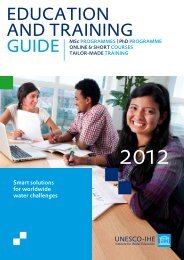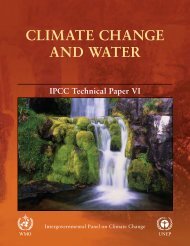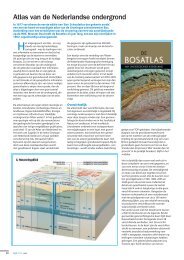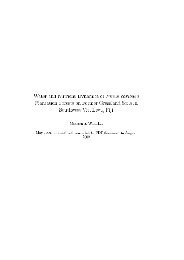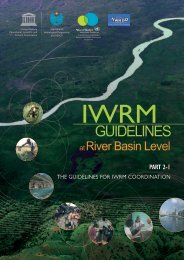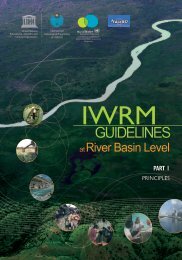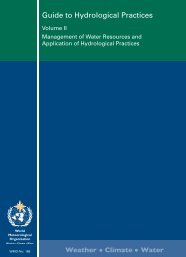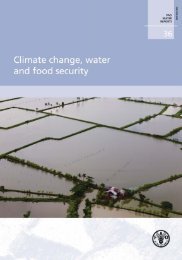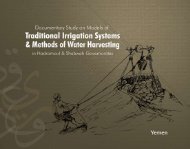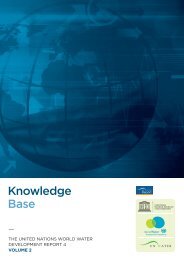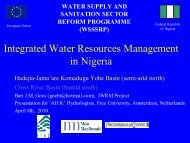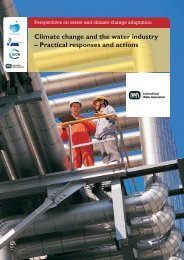Non-renewable groundwater resources: a ... - unesdoc - Unesco
Non-renewable groundwater resources: a ... - unesdoc - Unesco
Non-renewable groundwater resources: a ... - unesdoc - Unesco
- No tags were found...
Create successful ePaper yourself
Turn your PDF publications into a flip-book with our unique Google optimized e-Paper software.
CHAPTER 3 ■ AQUIFER CHARACTERISATION TECHNIQUESFurther field data are awaited to confirm or refute this finding, but it shows how modelling canbe used to challenge (and perhaps modify) the basic conceptual model of an aquifer system.A quasi-three dimensional finite element numerical model of the Western Jamahiriya Aquiferin Libya has been constructed to guide the de velopment of the Great Man-Made River Project -Phase II ((Pizzi and Sartori, 1984 and Pizzi, 1999). Model calibration was carried out usinghistorical data for the period 1970–90, and the model was then used to optimise the design ofwellfield layout, which consisted of 440 waterwells with production rates of 45–56 l/s. Aquifermodelling was based on extensive surveys and field observations programmes since the mid-1960s. Even then it had many initial flaws concerning the choice of boundary conditions, andwas later improved by incorporating the physical limits of the aquifer system and adopting theprevailing hydrodynamic conditions at those limits. In general terms, it can be said that ‘onetimemodelling‘ of an aquifer system is insufficient. It will always take several iterations before anumerical aquifer model is robustly calibrated and fully reliable as a tool for operational management.The modelling of this aquifer system is a good example of the need to carry-outrepeated model audits and upgrades. The original modelling of the mid-1970s was revised in theearly 1980’s and in the mid-1990s, each supported by new hydrogeological data from additionalexploratoration/observation wells. In each phase the outcome was an improvement in understandingand ability to predict wellfield performance and aquifer response.Risk assessment of long-term resource reliability is an important component of aquifermanagement modelling, where non-<strong>renewable</strong> <strong>groundwater</strong> <strong>resources</strong> are involved (Puri et al.,1999). This involves the identification of all potential hazards, ranking them in terms of theirprobability of occurrence and testing their significance in the numerical aquifer model. Suchanalysis permits the identification of the key hazards and allows management to focus on riskcontrol and mitigation.In summary, non-<strong>renewable</strong> <strong>groundwater</strong> resource assessment should include the followingphases :● construction and verification of a hydrodynamic simulation model, adequately representingthe structure and storage parameters of the aquifer system and predicting its non-steadystate response to long-term <strong>groundwater</strong> extraction;● design of possible production wellfields, compatible with potential demand from urban,industrial or agricultural development, including (as one option) maximising long-term<strong>groundwater</strong> output;● simulation of long-term <strong>groundwater</strong> extraction scenarios, for the purpose of examiningtheir practical feasibility and identifying their respective impacts.Importance of <strong>groundwater</strong> monitoringA high-level of uncertainty is inherent in the interpretation of <strong>groundwater</strong> resourceinvestigations in more arid climatic conditions. But the level of confidence in hydrogeologicalprognosis will increase greatly with the availability of some years of monitoring data onaquifer response to large-volume abstraction (Foster 1989). Thus a carefully-designed andsystematically-operated monitoring program is essential.The monitoring programme should be based on systematic periodic <strong>groundwater</strong> samplingand analyses, and commence as early as possible in the aquifer development cycle. A long-termperspective must be taken since balanced interpretation will necessitate more than a 45




